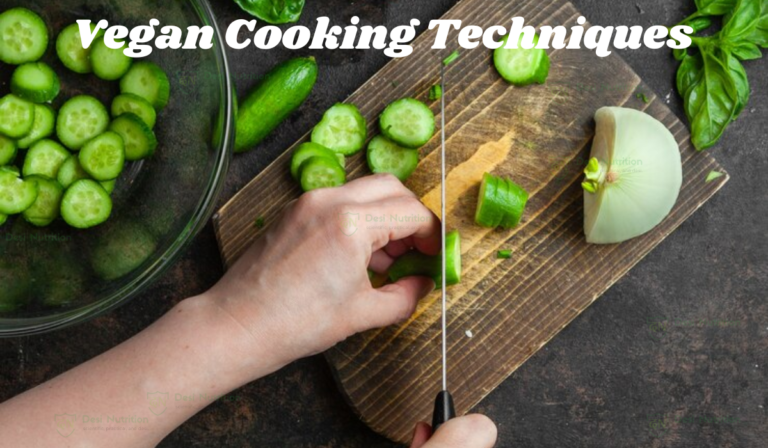Cooking vegan meals could be challenging and rewarding at the same time. You should cook at home to ensure you eat healthy. Moreover, vegan dishes are better made at home by using various ingredients including spices and herbs. In this article we will discover different vegan cooking techniques that you can opt for in your daily cooking.
First of all let’s talk about the importance of planning when it comes to preparing vegan meals. Remember, vegan meals are all plant-based, and if you would try to do the last minute purchase for your dish you might end up not finding the ingredients. So it is best to plan your meals beforehand and decide what cooking method you would use and what other ingredients you would need to make the dish.

Here are some vegan cooking techniques that can make your cooking creative and fun to do.
1. Sautéing and Stir-Frying: Quick and Flavorful Cooking

Sautéing and stir-frying are fast, high-heat and effective cooking methods that are perfect for vegan dishes because they retain most of the nutrients. Bothe techniques are considered healthy because they use a small amount of oil to cook ingredients over medium to high heat. This helps to lock the flavors and preserve nutrients of the ingredients. You can prepare vegetables, tofu and plant-based proteins.
How to Sauté and Stir-Fry:
- To begin, heat a tablespoon of oil (olive, avocado, or sesame oil) in a pan over medium-high heat.
- Then add ingredients like sliced onions, garlic, and ginger to infuse the oil with flavor.
- After that add vegetables, tofu, tempeh, or seitan, stirring constantly to cook evenly without burning.
- Now, season with salt, pepper, soy sauce, or other flavor-enhancing liquids near the end of cooking.
Pro Tips:
- For sauteing vegetables, use high-smoke-point oils like grapeseed or avocado oil to prevent burning at high heat.
- When stir-frying, prepare all your ingredients ahead of time because cooking happens quickly.
- For even cooking, cut vegetables into uniform sizes and shapes.
Example Recipe: Stir-Fried Tofu and Vegetables
- Heat 1 tbsp of sesame oil in a pan.
- Add garlic and ginger, then tofu cubes, browning them on all sides.
- Toss in bell peppers, broccoli, and snap peas, cooking until tender but crisp.
- Finish with soy sauce and a splash of rice vinegar.
2. Roasting: Deep Flavors with Minimal Effort

You can use roasting to bring out the natural sweetness and depth of the flavor in vegetables. It is a cooking technique that makes the vegetables crispy on the outside and tender on the inside. Roasting is perfect for root vegetables like sweet potatoes, carrots, and beets, as well as cruciferous vegetables like broccoli, cauliflower, and Brussels sprouts.
How to Roast:
- First of all, preheat the oven to 400°F (200°C).
- Then cut vegetables into even-sized pieces to ensure consistent cooking.
- Then you need to toss vegetables with olive oil, salt, pepper, and any herbs or spices (rosemary, thyme, paprika).
- Make sure you spread vegetables evenly on a baking sheet, avoiding overcrowding.
- After that, roast the vegetables for 20-45 minutes, depending on the vegetable, stirring halfway through for even browning.
Pro Tips:
- For extra crispiness, crank up the oven to 425°F (220°C) and finish roasting under the broiler for 1-2 minutes.
- Roasted garlic adds a deep, caramelized flavor—simply wrap a bulb in foil and roast alongside your veggies.
Example Recipe: Roasted Root Vegetable Medley
- Cut sweet potatoes, carrots, and parsnips into bite-sized pieces.
- Toss with olive oil, salt, pepper, and rosemary.
- Roast at 400°F for 30-35 minutes, stirring halfway through.
3. Steaming: Retaining Nutrients and Fresh Flavors

Steaming is one of the healthiest cooking methods as it preserves the nutrients, colors, and flavors of vegetables. This method uses moist heat to cook ingredients without submerging them in water. This way the nutrients are retained.
How to Steam:
- You need to fill a pot with 1-2 inches of water and bring to a simmer.
- Then place a steaming basket over the water, ensuring it doesn’t touch the liquid.
- At last add vegetables, cover, and steam until tender (usually 5-10 minutes).
Pro Tips:
- If you want to infuse extra flavor, season your steaming water with herbs, lemon slices, or garlic.
- You should check the texture of your vegetables frequently to prevent overcooking.
Example Recipe: Steamed Broccoli with Lemon Tahini Dressing
- Steam broccoli florets for 5-7 minutes until bright green and tender.
- Drizzle with a dressing made from tahini, lemon juice, garlic, and a pinch of salt.
4. Blending and Pureeing: Creating Smooth and Creamy Dishes
Blending and pureeing are some techniques in vegan cooking. This technique will help you to easily make some of the dishes like soups, sauces, dips and smoothies. Blending ingredients together helps to break them down into a smooth, creamy, consistency which makes it an ideal component in many dishes.
How to Blend and Puree:
- Use a high-speed blender or food processor to puree cooked ingredients like roasted vegetables or beans.
- Gradually add water, vegetable broth, or plant-based milk to achieve the desired consistency.
Pro Tips:
- To make creamy soups without dairy, blend vegetables like potatoes, cauliflower, or butternut squash.
- Blend soaked cashews or silken tofu to create creamy vegan dressings, sauces, or desserts.
Example Recipe: Creamy Roasted Red Pepper Soup
- Roast red bell peppers, onions, and garlic.
- Blend the roasted vegetables with vegetable broth and a touch of coconut milk for creaminess.
- Season with smoked paprika and cayenne for a smoky kick.
5. Marinating: Infusing Bold Flavors
Marinating is a technique used to enhance the flavor and tenderness of ingredients like tofu, tempeh, seitan, or vegetables. A good marinade typically contains an acid (like lemon juice or vinegar), oil, and seasonings. The acid breaks down the fibers of plant-based proteins, allowing the flavors to penetrate more deeply.
How to Marinate:
- Mix together your marinade ingredients in a bowl or resealable bag.
- Submerge the tofu, tempeh, or vegetables, and marinate for at least 30 minutes (overnight for more intense flavor).
- Grill, bake, or sauté the marinated ingredients.
Pro Tips:
- Press tofu before marinating to remove excess water and improve flavor absorption.
- Experiment with different flavor profiles, such as soy sauce, garlic, ginger, and lime for an Asian-inspired marinade or olive oil, lemon, and oregano for a Mediterranean feel.
Example Recipe: Marinated Grilled Tofu
- Marinate tofu cubes in soy sauce, rice vinegar, ginger, and garlic for 1 hour.
- Grill the tofu on medium heat for 5-7 minutes on each side until charred and crispy.
6. Baking: Vegan Sweets and Savories
Baking is another crucial skill in vegan cooking, whether you’re making desserts or savory dishes like casseroles and breads. With a few plant-based substitutions, you can replicate the textures of traditional baked goods while keeping them vegan.
How to Bake Vegan:
- Replace eggs with flax seeds, chia seeds, mashed bananas, or applesauce.
- Use plant-based milks (almond, soy, oat) in place of dairy milk.
- Swap butter with coconut oil, margarine, or vegan butter substitutes.
Pro Tips:
- Use aquafaba (the liquid from a can of chickpeas) to replicate the airy texture of egg whites in meringues or mousses.
- For fluffier baked goods, add a tablespoon of apple cider vinegar to your plant-based milk to create a buttermilk substitute.
Example Recipe: Vegan Banana Bread
- Mash 3 ripe bananas and mix with 1/3 cup of melted coconut oil.
- Combine with flour, baking soda, vanilla, and a flax egg (1 tbsp flaxseed meal mixed with 3 tbsp water).
- Bake at 350°F for 45-50 minutes until golden brown and a toothpick comes out clean.
7. Fermenting: Boosting Flavor and Gut Health
Fermentation is an ancient technique that preserves food while enhancing its nutritional value and flavor. Fermented foods like kimchi, sauerkraut, and tempeh are rich in probiotics, which promote gut health.
How to Ferment:
- For sauerkraut: Massage shredded cabbage with salt to release its juices, pack it tightly into a jar, and let it ferment at room temperature for 1-2 weeks.
- For kimchi: Mix vegetables with a spiced paste (usually garlic, ginger, chili flakes), then pack them into jars to ferment.
Pro Tips:
- Keep fermenting jars in a dark, cool place and check them regularly to release built-up gasses.
- Adjust the fermenting time based on your taste preference; longer fermentation results in stronger flavors.
Example Recipe: Homemade Sauerkraut
- Shred 1 small cabbage and massage with 1 tbsp of salt.
- Pack the cabbage into a clean jar, ensuring it’s submerged in its juices.
- Cover with a cloth and let ferment at room temperature for 1-2 weeks.
Frequently Asked Questions
Is vegan cooking difficult?
Ans. Vegan cooking is as easy as your regular cooking. The only difference is the ingredients used in the cooking process are all plant-based.




